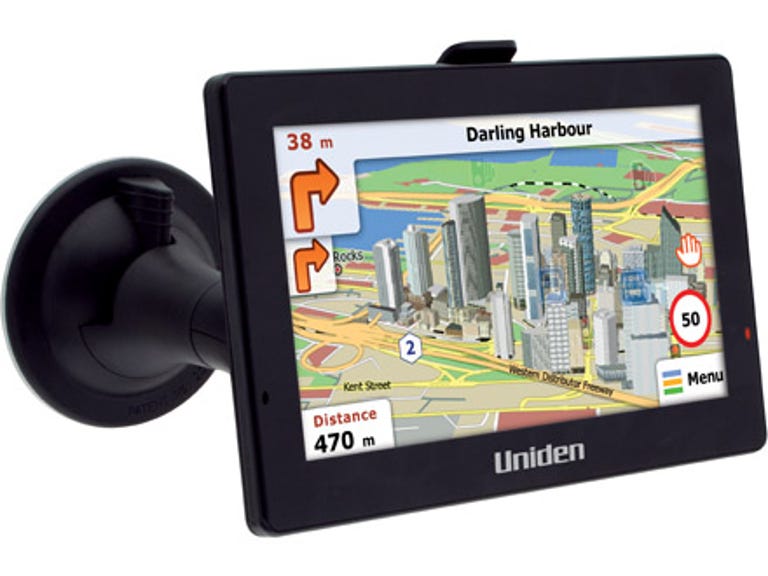 Why You Can Trust CNET
Why You Can Trust CNET Uniden Trax 5000 review: Uniden Trax 5000
The Trax 5000 is not without its faults but its size and legibility make a compelling case.
Design
We approached this latest Uniden GPS with a slight sense of fear and foreboding because the previous generation Trax models were encumbered with navigation software supplied by iGo that was both complex, unintuitive and just a little bit ugly. Our fears were soon allayed, as the latest version of the iGo software has been given a thorough makeover from top to tail and is unrecognisable from the last.
The Good
The Bad
The Bottom Line
The glossy, flush 5-inch screen mightn't be overly endowed in the pixel department, but text is large and clear, and the map easy to discern. Despite Uniden's claims, the screen does reflect street lights and daylight, although it's nowhere as distracting in our experience as the iPhone 3G. Another bugbear from last year's models, the windscreen mount, has been improved out of sight; it's now reasonably compact and is no longer a nightmare to use.
The map screen is now clear and uncluttered. In the bottom left corner is an info box with the current speed, the speed limit and the time. A menu button exists in the bottom right corner, with the next turn instruction and street name plastered across the top. A tap on the map gives you access to a bunch of shortcuts, including a volume slider. Screens slide and fade neatly in and out of view, and the menu system is now almost a paragon of lucidity and ease of use.
A miniature version of the map is shown in the main menu, but getting back to the map screen can take a few clicks if you're a long way in. Destination entry is hampered by the lack of an on-screen QWERTY keyboard — the only one available is an unfamiliar ABCDE version. Lists can be scrolled through via the now familiar finger swipe and despite the screen being of the resistive, not capacitive, variety, it generally works well and puts many a Navman to shame.
Features
Bringing a 5-inch GPS to market for so little money does demand a few sacrifices; so, adieu traffic messaging, ciao Bluetooth hands-free and tschüss MP3 playback. There are, however, games and a picture viewer, if you're interested in those things. Notable features that make the cut include lane guidance, 3D landmarks and modelled cityscapes, lane guidance and street signage, and text-to-speech.
While text-to-speech is a great boon for drivers, the Trax 5000 only offers one such voice, an American one. Moving beyond the obvious jokes, it makes a fair fist of pronouncing Aussie street names, although constantly mispronouncing "road" as "rod" doesn't do it any favours. Nor does occasionally uttering route numbers instead of street names or chopping off a road name in its haste to blurt out the next instruction.
Approaching red light and speed cameras aren't heralded by a warning tone, but just a rather meek set of icons in the bottom right corner. In addition to the gimmicky 3D landmarks (oh, hey, there's a poor rendition of the Sydney Opera House that I'm driving towards), the Trax 5000 adds grey rectangular blocks that model the CBD-scape (do I turn left after tall grey rectangle or slightly shorter grey rectangle?).
Performance
Without a standby mode the Trax 5000 takes at least 40 seconds to start up, and combined with the sometimes glacial GPS acquisition, getting set-up for a drive can be a lengthy affair. Performance in the CBD is quite good, with only the occasional drop out. Routing calculation times are nothing out of the ordinary, as are the routes themselves — it's not quite like having a local guide you around, but you'll eventually arrive at your destination.
Maps for Australia (Whereis) and New Zealand come preloaded on the Trax 5000. Lane guidance appears prominently at the bottom screen for many roads, but coverage isn't quite as comprehensive as units from TomTom and Garmin. Virtual street signs appear for highway and motorway exits and intersections, and while terrain data is included in the package, it's only really noticeable in route overviews and when you head out into the bush.
Conclusion
The Trax 5000 is not without its faults — chiefly the missing QWERTY keyboard and camera alerts, and text-to-speech that's limited to an American accent — but for size and legibility it can't be beat.


